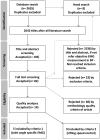A systematic review of surface electromyography analyses of the bench press movement task
- PMID: 28170449
- PMCID: PMC5295722
- DOI: 10.1371/journal.pone.0171632
A systematic review of surface electromyography analyses of the bench press movement task
Abstract
Background: The bench press exercise (BP) plays an important role in recreational and professional training, in which muscle activity is an important multifactorial phenomenon. The objective of this paper is to systematically review electromyography (EMG) studies performed on the barbell BP exercise to answer the following research questions: Which muscles show the greatest activity during the flat BP? Which changes in muscle activity are related to specific conditions under which the BP movement is performed?
Strategy: PubMed, Scopus, Web of Science and Cochrane Central Register of Controlled Trials (CENTRAL) in the Cochrane Library were searched through June 10, 2016. A combination of the following search terms was used: bench press, chest press, board press, test, measure, assessment, dynamometer, kinematics and biomechanics. Only original, full-text articles were considered.
Results: The search process resulted in 14 relevant studies that were included in the discussion. The triceps brachii (TB) and pectoralis major (PM) muscles were found to have similar activity during the BP, which was significantly higher than the activity of the anterior deltoid. During the BP movement, muscle activity changes with exercise intensity, velocity of movement, fatigue, mental focus, movement phase and stability conditions, such as bar vibration or unstable surfaces. Under these circumstances, TB is the most common object of activity change.
Conclusions: PM and TB EMG activity is more dominant and shows greater EMG amplitude than anterior deltoid during the BP. There are six factors that can influence muscle activity during the BP; however, the most important factor is exercise intensity, which interacts with all other factors. The research on muscle activity in the BP has several unresolved areas, such as clearly and strongly defined guidelines to perform EMG measurements (e.g., how to elaborate with surface EMG limits) or guidelines for the use of exact muscle models.
Conflict of interest statement
The authors have declared that no competing interests exist.
Figures
References
-
- Chulvi MI, Díaz CA. Efficacy and safety of the bench press exercise. Review. Revista Internacional de Medicina y Ciencias de la Actividad Fisica y del Deporte. 2008;8(32):338–52.
-
- Castillo F, Valverde T, Morales A, Pérez-Guerra A, de León F, García-Manso JM. Maximum power, optimal load and optimal power spectrum for power training in upper-body (bench press): A review. Revista Andaluza de Medicina del Deporte. 2012;5(1):18–27.
-
- Enoka RM, Duchateau J. Inappropriate interpretation of surface EMG signals and muscle fiber characteristics impedes understanding of the control of neuromuscular function. J Appl Physiol. (Bethesda, Md: 1985). 2015;119(12):1516–8. - PubMed
-
- Vigotsky AD, Ogborn D, Phillips SM. Motor unit recruitment cannot be inferred from surface EMG amplitude and basic reporting standards must be adhered to. J Appl Physiol. 2015:1–2. - PubMed
Publication types
MeSH terms
LinkOut - more resources
Full Text Sources
Other Literature Sources
Medical


